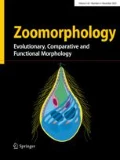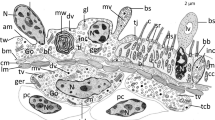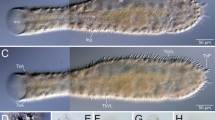Summary
The lateral organs (amphids) of Tobrilus aberrans, invaginations of the epidermis, are at their base in association with 16 dendrites, each of which has one modified cilium. The epidermal invagination is lined distally (in the region of fovea and canalis) by a cuticle, which differs in its ultrastructure from the cuticle covering the surface of the body. In the region of the fusus the cuticle is lacking. The 16 dendritec cilia enter the fovea via the canalis and exhibit differing cross-sections if cut at various distances from their origin. In the fusus they are constructed according to a 9 × 2 + 0 pattern; this order is lost as they approach the canalis, in the fovea they additionally loose the circular outline of their cross-section. The fovea is filled by the corpus gelatum which does not extend beyond the apertura.
Zumammenfassung
Die Seitenorgane (Amphiden) von Tobrilus aberrans stellen Einstülpungen der Epidermis dar, an die basal 16 Dendriten herantreten, die apikal je eine modifizierte Cilie tragen.
Die Epidermiseinstülpung ist distal (im Bereich von Fovea und Canalis) cuticularisiert. Die Cuticula in diesem Bereich weist Bauunterschiede zu der der Körperoberfläche auf.
Im Bereich des Fusus findet sick keine Cuticula.
Die 16 Cilien der Dendriten treten über den Canalis in die Fovea ein und weisen auf verschiedener Entfernung von ihrer Insertion einen unterschiedlichen Querschnitt auf. Im Fusus sind sie nach dem 9×2+0-System aufgebaut, weiter distal verlieren sie die Ordnung ihrer Binnenstruktur und ihren kreisförmigen Querschnitt.
Die Fovea wird vom Corpus gelatum ausgefüllt, das nicht aus der Apertura heraustritt.
Similar content being viewed by others
Literatur
Bird, A. F.: The structure of nematodes, 318 pp. New York-London: Academic Press 1971.
Filipjev, 1. N.: Freilebende Meeresnematoden aus der Umgebung von Sewastopol [Russ.]. Trudy osob. zool. Lab. sebastop. biol. Sta. (2) 4, 614 pp. 11 pl. (seit 1970 gibt es eine englische Übersetzung aus dem Israel Program for Scientific Translations, Jerusalem) (191821).
Hirumi, H., Chen, T.: Electron microscopic studies of the nervous system of Trichodorus christiei. Phytopathology 58, 1053 (1968).
Hope, W. D.: A taxonomic review of the genus Thoracostoma Marion, 1870 (Nematoda; Leptosomatidae), and a study of the histologic morphology of Thoracostoma californicum Steiner and Albin, 1933. Ph.D. dissertation, University of California, Davis [Diss. Abstr. 26, 2389–2390 (1965)].
Kozek, W. J.: Unusual cilia in the microfilaria of Dirofilaria immitis. J. Parasit. (Lawrence, Kan.) 54, 838–844 (1968).
McLaren, D. J.: Ciliary structures in the microfilaria of Loa loa. Trans. roy. Soc. trop. Med. Hyg. 63, 290–291 (1969).
McLaren, D. J.: Preliminary observations in the sensory structures in adult Filariae. Trans. roy. Soc. trop. Med. Hyg. 64, 191–192 (1970).
Moritz, K., Storch, V.: Über den ultrastrukturellen Bau der Skaliden von Trachydemus giganteus (Kinorhyncha). Marine Biol. 16, 81–89 (1972).
Poinar, G. O., Leutenegger, R.: Anatomy of the infective and normal third stage juveniles of Neaplectana carpocapsae Weiser (Steinernematidae: Nematoda). J. Parasit. 54, 340–350 (1968).
Raski, D. J., Jones, N. O., Roggen, D. R.: On the morphology and ultrastructure of the esophageal region of Trichodorus allius Jensen. Proc. helminth. Soc. Wash. 36, 106–118 (1969).
Riemann, F.: Corpus gelatum und ciliäre Strukturen als lichtmikroskopisch sichtbare Bauelemente des Seitenorgans freilebender Nematoden. Z. Morph. Tiere 72, 46–76 (1972).
Riemann, F., Rachor, E., Freudenhammer, L.: Das Seitenorgan von Halalaimus. Zur Morphologie eines vermutlich sensorischon Organs von freilebenden Nematoden. Veröff. Inst. Meeresforsch. Bremerh. 12, 429–441 (1970).
Roggen, D. R., Raski, D. J., Jones. N. O.: Further electron microscopic observations of Xiphinema index. Nematologie 13, 1–16 (1967).
Ross, M. M. R.: Modified cilia in sensory organs of iuvenile stages of a parasitic nematode. Science 156, 1494–1495 (1967).
Taylor, C. E., Thomas, P.R., Robertson, W. M., Roberts, I. M.: An electron microscope study of the oesophageal region of Longidorus elongates. Nematologica 16, 6–12 (1970).
Yuen, P. H.: Electron microscopical studies on the anterior end of Panagrellus silusiae (Rhabditidae). Nematologica 14, 554–564 (1968).
Author information
Authors and Affiliations
Rights and permissions
About this article
Cite this article
Storch, V., Riemann, F. Zur Ultrastruktur der Seitenorgane (Amphiden) des limnischen Nematoden Tobrilus aberrans (W. Schneider, 1925) (Nematoda, Enoplida). Z. Morph. Tiere 74, 163–170 (1973). https://doi.org/10.1007/BF00280785
Received:
Issue Date:
DOI: https://doi.org/10.1007/BF00280785




